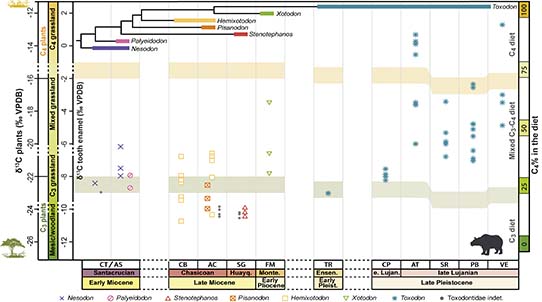Stable isotope analysis evidences dietary changes in toxodontids (Mammalia, Notoungulata) across the Neogene-Quaternary from Argentina
DOI:
https://doi.org/10.7203/sjp.28828Keywords:
Late Cenozoic, Macroevolution, Niche Evolution, Paleoecology, South America, Vegetation. Abstract
Abstract
Toxodontidae was an extinct family of South American notoungulates, widely studied systematically, but not so much from an ecological perspective. This work aims to improve the knowledge about variations in diet and habitats of different representatives of this group in the context of biotic and abiotic events throughout the last 20 My. The tooth enamel carbon isotope composition (δ13C) of 7 genera recorded in 11 localities of Central, West and Northeastern Argentina, from the Early Miocene to the Late Pleistocene, was analyzed. The diet of the toxodontids studied in this work range from mainly C3 resources during the Miocene, mixed C3-C4 in the Pliocene, to a significant consumption of C4 plants during the Pleistocene. Differences in diet during the Late Pleistocene were also recorded, associated with geographic (i.e., Northeastern vs. Central) and temporal (i.e., glacial vs. interglacial periods) variations, evidencing the adaptive capacity of the group under ecological and environmental pressures.
 Downloads
Downloads

Downloads
Published
How to Cite
-
Abstract537
-
PDF97
Issue
Section
License
Copyright (c) 2024 Dánae Dánae Sanz-Pérez, Rodrigo L. Tomassini, Claudia I. Montalvo, Alfredo Zurita, Manuel Hernández-Fernández, Laura Domingo

This work is licensed under a Creative Commons Attribution-NonCommercial 4.0 International License.
![]()
This is an open-access article distributed under the terms of the Creative Commons Attribution 4.0 International License.


